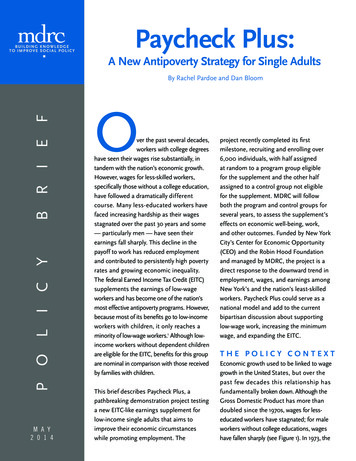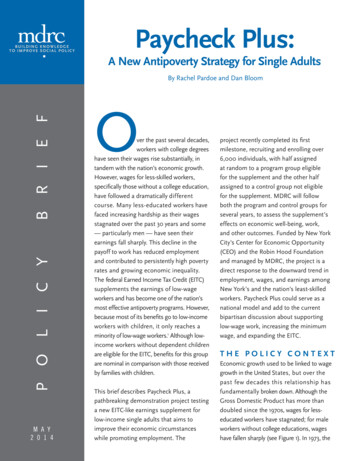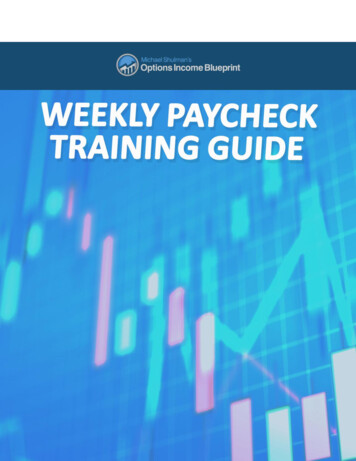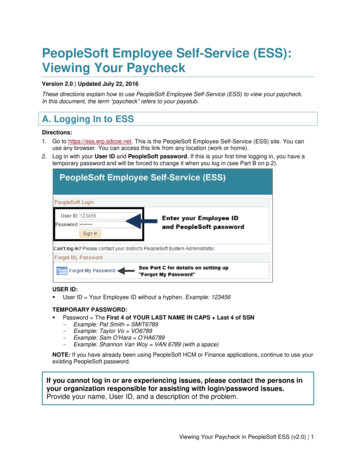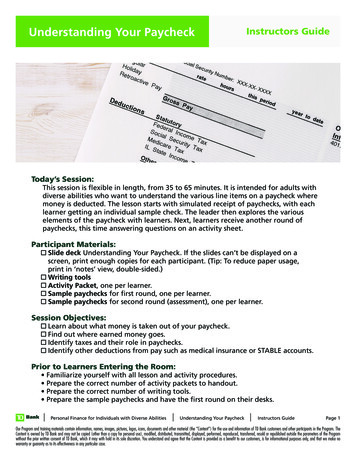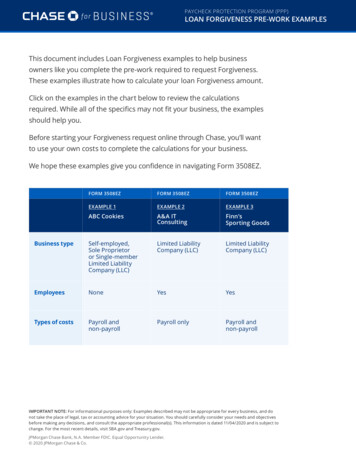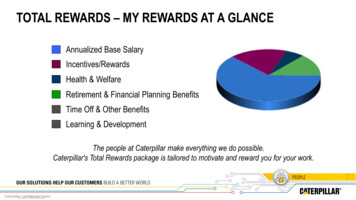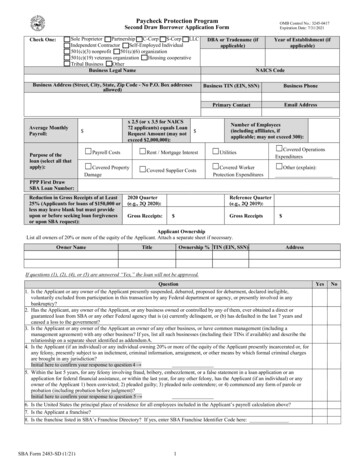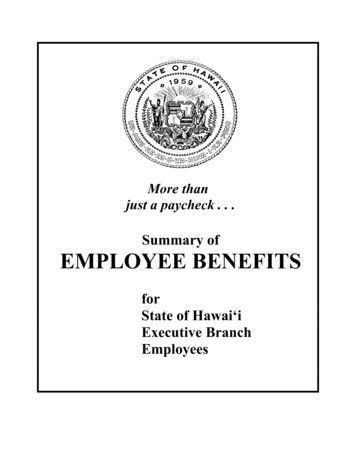
Transcription
More thanjust a paycheck . . .Summary ofEMPLOYEE BENEFITSforState of Hawai‘iExecutive BranchEmployees
Table of ContentsDisclaimer . iiMessage to State of Hawai‘i Employees. 1Public Service - Shaping Hawaii’s Future . 2More Than Just a Paycheck . 2Family Time and Values . 2Holidays / Vacation Leave / Sick Leave / Other Leaves . 3, 4, 5Health Benefits . 6,7Retirement Program . 8,9,10,11,12Pre-Tax Benefit Programs . 13,14Other Benefit Programs . 15,16Training and Continuing Education . 17Comparative Benefits - State vs. National Average . 18For More Information . 19Departmental Human Resources Office Contact Numbers .20i
DISCLAIMERImportant Disclaimer: This booklet has been prepared for yourconvenience. It is intended as a reference guide and contains generaldescriptions and summaries of various policies, benefits, procedures, andrules. This booklet is not a contract or binding agreement. It does notsupersede laws, rules, collective bargaining agreements, executive orders,policies and procedures, and benefit plan documents pertaining to thevarious subject matters covered. Benefits vary by type of employmentappointment, collective bargaining agreement and federal and state law,and are subject to change.For further information, please contact your Departmental HumanResources Office (HRO) designee or refer to the applicable laws, rules,collective bargaining agreements, executive orders, policies andprocedures, or benefit plan documents.ii
MESSAGE TO STATE OF HAWAI‘I EMPLOYEESAs an employee of the State of Hawai‘i, you are part of our ‘ohana - our family.And families care about each other, which is why we offer you a compensationpackage designed to meet your needs now and throughout your career with theState.The salary you receive from the State is only a part of your total compensation.We’d like to help you understand more about the total compensation package youreceive as a valued member of our State team.This booklet summarizes the State’s benefit programs which provide the economicsecurity and quality of life that you and your family want today and in the future.Our objective is to meet the needs of each eligible employee - for careeradvancement, vacation/sick leave, medical and retirement benefits, and electiveleave for family crisis. These are at the heart of our total compensation plan.We hope you find the booklet helpful in meeting your informational needs.If you have questions or want additional information, your Departmental HumanResources Office will be able to help you get the answers you need.1
PUBLIC SERVICE - SHAPING HAWAII’S FUTUREWorking for the State means working for Hawai‘i.As stewards of our State, you provide vital services to our citizens, contribute tothe growth and development of Hawaii’s economy, and make Hawai‘i a betterplace to live. You have good reason to be proud, because you and your fellowemployees are the ones who lead this great State forward.MORE THAN JUST A PAYCHECKThe State of Hawai‘i is one of Hawaii’s largest employers and offers you acompetitive compensation package. Your total compensation is comprised of yoursalary and your benefits.In addition to your salary, which is an important part of your compensationpackage, you may be eligible for a broad range of valuable benefits, such ascomprehensive health care insurance, life insurance, retirement programs, sickleave, vacation leave, and holidays. All of these are part of compensation that goesbeyond salary.FAMILY TIME AND VALUESWe understand that preserving and promoting family time and values arevery important.We know that you need to spend quality time with your family. Most State jobs areconducive to a standard workday with regular work hours. And because the Stateholiday calendar is essentially the same as the public-school system’s calendar,many parents can enjoy celebrating the holidays with their children. The State alsogives each department the option to implement flexible working hours or analternative workweek program. Please check with your supervisor and/or yourDepartmental Human Resources Office for more information.2
HOLIDAYS / VACATION LEAVE / SICK LEAVE / OTHERLEAVESThe State offers an attractive holiday, vacation, and sick leave package toeligible salaried employees.HolidaysThe State observes 13 holidays per year and 14 during an election year,compared to an average of 8 holidays offered by many private companies.These observed holidays, as defined in the Hawai‘i Revised Statutes, can beviewed at http://dhrd.hawaii.gov/Vacation and Sick LeavesThe State provides for a more generous vacation and sick leave policy thanthose offered by most private companies.Vacation LeaveYou may earn vacation leave at a rate that other employers find tough tomatch – up to 21 days each full year from the first year of employment, comparedto an average of 10 days offered by private companies. And you may accumulateand carry over your vacation leave from year to year, within limits.Sick LeaveLike vacation, you may earn sick leave at the same rate – up to 21 days peryear which may be accumulated and carried over from one year to the next.Plus, unused accumulated sick leave may eventually be used to increase yourretirement benefits in certain situations.3
Family LeaveUnder the Hawai‘i Family Leave Law and rules, you may be eligible for up tofour (4) weeks of unpaid family leave each calendar year for the following reasons: Birth of a child; Placement of a child with you for adoption; To care for your child, spouse, reciprocal-beneficiary, sibling, grandchild,or parent with a serious health condition.You may substitute your accrued paid leave (i.e., vacation or sick leave) for any partof the State Family Leave. However, only the accrued and available sick leave inexcess of the fifteen (15) days required under the State’s self-insured TemporaryDisability Benefits Plan, can be applied toward family leave purposes.Under the Federal Family and Medical Leave Act (FMLA), you may be eligiblefor up to twelve (12) weeks of unpaid FMLA leave during any 12-month period,which is defined as a calendar year for State employees. You may be eligible for thefollowing reasons:Birth of a child, and to care for your newborn child;Placement of a child with you for adoption or foster care;To care for your child, spouse, or parent with a serious health condition;If you suffer from a serious health condition that makes you unable to performthe functions of your job. “Qualifying Exigency Leave”- Your spouse, son, daughter, or parent is amilitary member on covered active duty or called to covered active-dutystatus (or has been notified of an impending call or order to covered activeduty) in the Armed Forces. “Military Caregiver Leave,” also under the FMLA, may allow you to take up totwenty-six (26) work weeks of unpaid leave in a “single twelve (12)-month period” tocare for your military relative (spouse, child, parent, or next of kin) if he/she/they hasa qualifying serious illness or injury.If you qualify for both State Family Leave and FMLA, both leave periods will runconcurrently. For example, if you take family leave to care for your spouse with aserious health condition, you may take 4 weeks of State Family Leave and anadditional 8 weeks of FMLA leave - a maximum period of 12 weeks.4
Leave Sharing ProgramUnder the State’s Leave Sharing Program, you may be eligible to give andreceive donated vacation credits within your department. The purpose of this programis to ease the burden of fellow departmental co-workers who would otherwise need totake time off from work without pay to recover from a serious personal illness/injuryor to care for a family member who has a serious personal illness/injury and isincapable of self-care. If you are interested in donating any of your vacation leavecredits or wish to request leave sharing, contact your Departmental Human ResourcesOffice.Other LeavesYou may be eligible for other leaves, such as: Bereavement LeaveJury dutyMilitary LeaveVictims LeaveParent-Teacher ConferencesFoster Parent Leave to attend family court hearingsDisaster ReliefBlood Bank DonationsBone Marrow TestingBone Marrow / Organ DonationUpon request and approval, you may be eligible for certain leaves of absence withoutpay for up to one year.For more specific information, check your collective bargaining agreement and/orcontact your Departmental Human Resources Office.5
HEALTH BENEFITSThe State offers eligible employees a choice of health insurance plans medical/drug, dental, and vision- through the Hawai‘i Employer-Union HealthBenefits Trust Fund (EUTF).The employer pays a share, and your cost is the remaining portion of the healthcare plans’ monthly premiums – so the cost to you will depend on the particularplan you choose and the bargaining unit to which you belong. Your contributionsare made through payroll deduction.There is no waiting period for your initial enrollment when you are hired, whichmeans immediate coverage for you and your eligible family members. Please beaware that your actual enrollment may not be processed immediately, but if you oryour family require services, please contact the EUTF for assistance. Wheneveryou have changes (e.g., marriage) that could affect the coverages under your healthcare plan, please report those changes immediately (within 45 days) to yourDepartmental Human Resources Office.When you retire from the State, you may be eligible for health insurance benefits.Based on current law and subject to change by the Legislature, your employer willcontribute to your premiums based upon when you were hired and the number ofyears of credited service you have at the time of your retirement (see chart below).Number of Years of CreditedService (excluding sick leave)At Retirement5 but less than 10 years10 but less than 15 years15 but less than 25 years25 or more years*You were hiredbefore 7/1/9650%100%100%100%State’s Base Monthly Contributions*You were hiredYou were hired7/1/96 – 6/30/01on or after 7/1/01**0%0%50%50%75%75%100%100%The Base Monthly Contribution (BMC) is based on the statutory cap which is adjusted each year dependingupon changes to the Medicare Part B premiums. If the actual health plan premiums are greater than theBMC, the retiree will be required to pay the difference.** If you were hired on or after 7/1/2001, the State’s base monthly contribution will be only for you (i.e., nocontributions will be made for your dependents). If you were hired before 7/1/2001, the State’s basemonthly contribution will be for both you and your dependents.You are eligible to enroll in any available plans at the time of your retirementregardless of what plans, if any, you were enrolled in just prior to retirement.For more information on the health care plans offered by EUTF, contact yourDepartmental Human Resources Office or the EUTF office at 808-586-7390 or6
toll-free at 1-800-295-0089. You may also visit the EUTF website atwww.eutf.hawaii.gov7
RETIREMENT PROGRAMThe Employees’ Retirement System (ERS) was established in 1926 toprovide retirement, disability, and survivor benefits to State and countygovernment employees. The general administration of the ERS is under thedirection of a Board of Trustees, with certain areas of administrative control withthe State Department of Budget and Finance.The ERS is a qualified pension plan under Section 401(a) of the Internal RevenueCode where member’s retirement contributions are tax deferred. Also, the ERS is adefined-benefit plan where your pension is based on your salary and years ofservice.The plan consists of Contributory, Noncontributory, and Hybrid members.Contributory and Hybrid members are required to make contributions to the ERS.Noncontributory members do not make contributions. Most of the new employeesare required to be members in the Hybrid plan which has two (2) benefit structuresbased on the membership date either before or on/after July 1, 2012.Please refer to the plan summary for a more detailed explanation. For moreinformation, you may visit the ERS website at https://ers.ehawaii.gov or call theoffice at 808- 586-1735.8
GENERAL RETIREMENT INFORMATIONService RetirementAs a defined benefit plan, your pension is based on your:1. Years and months of ERS membership service2. Average Final Compensation (AFC)*3. Benefit percentagePension Calculation Formula:Years of Service x AFC x Benefit Percentage Maximum Allowance*AFC (Average Final Compensation) is determined by your membership date.Membership DateAfter June 30, 2012Prior to July 1, 2012Prior to January 1, 1971AFC Calculation (Highest five or three years)Highest five (HI-5) years of base pay earnings excluding any lump sumvacation payHighest three (HI-3) years of earnings including overtime, recurringdifferentials, and excluding any lump sum vacation pay.Comparison HI-3 years of earnings excluding any vacation pay or HI-5 ofearnings including lump sum vacation pay, whichever is greater.Disability RetirementThe ERS offers disability retirement for members who are permanently unable to perform their workduties. The ERS Medical Board certifies your disability which is approved by the Board of Trustees. Ifyou are unable to work, please contact the ERS as you may be eligible for disability retirement.Ordinary Death BenefitsAn “Active Death” or “Ordinary Death” is when a member dies in active service or while on anauthorized leave without pay and the death is not the result of an accident occurring while in the actualperformance of duty.For Hybrid and Contributory plan members, death benefits are paid to the member’s designatedbeneficiary(ies) on the ERS Form 1-A Contributory/Hybrid Plan Designation of Beneficiary. By law(88-93), the designation becomes null and void when:1.2.3.4.the beneficiary predeceases the member or former employee;the member or former employee is divorced from the beneficiary;the member or former employee is unmarried, and subsequently marries; orthe member or former employee enters into or terminates a reciprocal beneficiary* relationship.Therefore, it is very important that your beneficiary designation be current. The ERS Form 1-A can befound on the ERS website at https://ers.ehawaii.gov/resources/all-forms.For Noncontributory plan members the ordinary death benefit is payable to the surviving spouse orreciprocal beneficiary* until remarriage or entry into a new reciprocal beneficiary relationship.Dependent children may also be eligible for a monthly benefit until their 18th birthday.*“Reciprocal beneficiary”: legal partnership between two individuals over 18 years old who areprohibited from marriage. (Section 572C).9
Hybrid PlanHybrid Tier 2 Members(Membership date after June 30, 2012)*Employee Contribution Rate8% of salaryHybrid Tier 1 Members(Membership date prior to July 1, 2012)*Employee Contribution Rate6% of salaryRegular Service RetirementEligibility RequirementsAge 65 w/10 yosAge 60 w/30 yosRegular Service RetirementEligibility RequirementsAge 62 w/5 yosAge 55 w/30 yos**Early RetirementEligibility Requirements(Age Penalty)Age 55 w/20 yos**Early RetirementEligibility Requirements(Age Penalty)Age 55 w/20 yosBenefit Percentage1.75%Benefit Percentage2.0%Vesting Requirements10 yosVesting Requirements5 yosAverage Final Compensation(AFC)Average of 5highest years ofbase payAverage Final Compensation(AFC)Average of 3highest years ofgross payyos Years of Service*Interest earned on your mandatory employee contributions accrue at 4.5% (membership dates prior to7/1/2011) and 2% (membership dates after 6/30/2011).**Sewer workers, emergency medical technicians, and water safety officers may retire with 25 years ofcredited service (without an age penalty), subject to certain provisions and limitations.Note: Unused sick leave cannot be used to meet any service credit eligibility requirementPension Calculation Example #1 (Member has a membership date after June 30, 2012):Age 65 with 20 years of service and a monthly AFC of 2,50020 years of service x 2,500 x 1.75% 875/month (Maximum Allowance)If you also have a Noncontributory plan service, your Noncontributory plan service benefit willbe based on the following formula: 1.25% x years of Noncontributory service x AFC. Seeexample #2 below.Pension Calculation Example #2 (Member has a membership date prior to July 1, 2012, with asplit formula):Age 55 with 30 years of service and a monthly AFC of 3,00010 years is credited under the Noncontributory plan (1.25%)20 years is credited under the Hybrid plan (2%)Noncontributory: 10 years of service x 3,000 x 1.25% 375Hybrid:20 years of service x 3,000 x 2% 1,200Maximum monthly allowance 1,57510
Noncontributory PlanRetirement TypeRegular Service RetirementSpecial Categories: EmergencyMedical Technicians, SewerWorkers, and Water SafetyOfficers with the last 5 years inthat occupationEarly RetirementDeferred Retirement (Vestedand left State or County serviceprior to age 62)AgeEligibilityRequirementYears of ServiceEligibilityRequirementAge Reduction1030NoNoNone25No552065551030At least 20 yearsbut less than 30years6255556% age reduction for eachyear between age 55-62NoNo6% age reduction for eachyear between age 55-62Note: Unused sick leave cannot be used to meet any service credit eligibility requirementFor the Noncontributory plan members, there are no employee contributions, and the benefit percentageis 1.25%.Pension Calculation Example:Age 65 with 25 years of service and a monthly AFC of 4,50025 years of service x 4,500 x 1.25% 1,406.25/month (Maximum Allowance)11
Contributory PlanContributory Tier 2 Members(Membership date after June 30, 2012)Contributory Tier 1 Members(Membership date prior to July 1, 2012)*Employee Contribution Rate9.8% of salary*Employee Contribution Rate7.8% of salaryRegular Service RetirementEligibility RequirementsAge 60 w/10 yosRegular Service RetirementEligibility RequirementsAge 55 w/5 yos**Early Retirement EligibilityRequirements (Age Penalty)Age 55 w/25 yos**Early Retirement EligibilityRequirements (Age Penalty)Any age w/25 yosBenefit Percentage1.75%Benefit Percentage2.0%Vesting Requirements10 yosVesting Requirements5 yosAverage Final Compensation(AFC)Average of 5highest years ofbase payAverage Final Compensation(AFC)Average of 3highest years ofgross payyos Years of Service*Interest earned on your mandatory employee contributions accrue at 4.5% (membership dates prior to7/1/2011) and 2% (membership dates after 6/30/2011).**Sewer workers, emergency medical technicians, and water safety officers may retire with 25 years ofcredited service (without an age penalty), subject to certain provisions and limitations.Note: Unused sick leave cannot be used to meet any service credit eligibility requirementPension Calculation Example (Member has a membership date after June 30, 2012):Age 65 with 20* years of service and a monthly AFC of 2,50020 years of service x 2,500 x 1.75% 875/month (Maximum, Allowance)*Assuming all service is general category Contributory service (different rates apply to certain specialcategories of Contributory service, Noncontributory service, or Hybrid service).12
PRE-TAX BENEFIT PROGRAMSIn addition to comprehensive health benefits and a rich retirement program,the State offers you a variety of other valuable benefit programs.Premium Conversion PlanThe State’s Premium Conversion Plan (PCP) is a voluntary benefit programthat allows you to deduct your health plan premiums on a pre-tax basis. If you arean employee of the State, enrolled in any health care plan offered through theEUTF, and your payroll deductions are processed through the Department ofAccounting and General Services (DAGS), your income will be taxed after yourhealth care plan contributions are deducted, so your take-home pay should begreater than if you do not enroll in the PCP.Island avings Plan / Deferred Compensation Plan (IRC 457)One of the most important retirement benefits you have as a State employeeis the opportunity to participate in the Island avings Plan (I P), the State ofHawai‘i deferred compensation plan. This is a voluntary pre-tax retirement savingsplan designed to give you a tax break today and build a "nest egg" for your future.Should you choose to participate, your contributions are made before taxes throughthe convenience of payroll deduction. There are several types of savings andinvestment options from which to choose. You may withdraw your accumulatedfunds upon attainment of age 70½, if you experience a qualified unforeseenemergency, upon termination of employment, or retirement. Any money fromother section 457(b) deferred compensation plans that are rolled over into this plancan be withdrawn at any time. However, assets from other plans, such as 403(b)plans, pre-tax IRAs, or other qualified plans that are rolled into this plan, may besubject to a 10% federal tax penalty for withdrawals before age 59 ½, in addition toapplicable income taxes. In the event of your death, any remaining balance in theaccount will be available to your designated beneficiaries.And because the payroll deductions are made before taxes are withheld, you maybe able to save on your taxes with each paycheck. You can also take advantage oftax-deferred savings – this means your contributions, plus any interest andearnings, are not taxed until you start taking withdrawals, usually at retirement.For more information, please visit the website of the plan’s third-partyadministrator, Empower (formally Prudential Retirement), at:http://www.prudential.com/islandsavings. In addition, you may call Empower at13
1-888-71A-LOHA (1-888-712-5642), press option “1” for a Call CenterRepresentative or press option “2” for a Local I P Retirement EducationCounselor.Island Flex PlanSo often, we find ourselves making critical health choices or putting offnecessary health care because of the high unexpected costs not budgeted for in thefamily finances. Dependent care is also a financial concern for many familieswhere both partners, and especially single parents, need to work to support thehousehold. This means they must find suitable arrangements for dependent care,whether it be a baby-sitter, preschool, or after-school program for their child, oreven adult day care for their dependent spouse or parent.The State is pleased to offer you Island Flex, one of our employee benefitprograms which may help you save in taxes while you strive to maintain a qualitylifestyle. Island Flex FSA (flexible spending account) provides you with a way topay for your eligible health care expenses and dependent care expenses withTAX FREE money. By directing “before tax” money from your paycheck into oneor both of these accounts, you can put up to 41% of the money you are spending oneligible expenses back into your pocket. For many State employees, Island Flex isa great way to turn certain out-of-pocket medical/drug, dental, and vision expensesand dependent care expenses into tax savings and greater spendable income.For more information, please visit the website of the plan’s third-partyadministrator, National Benefit Services at: www.nbsbenefits.com/islandflex orcall their office at 808-465-2284 or 1-855-399-3035 (Toll Free).Flex Park ProgramThis benefit program enables State employees of the Executive Branch tohave eligible parking fees deducted before Federal, State, and FICA taxes arecalculated. Eligible parking fees are those for parking assignments in a lotadministered by the Department of Accounting & General Services. For moreinformation on FlexPark, please contact your Departmental Human ResourcesOffice.Pre-Tax Transportation Benefits (Bus Pass)This voluntary program enables eligible employees of the Executive Branchto deduct the cost of an adult monthly bus pass for TheBus through payrolldeduction before Federal, State, and FICA taxes are calculated and have themonthly pass conveniently loaded on their HOLO card. For more information on14
the Pre-Tax Transportation Benefits (PTBP) Program, please contact your PTBPDepartment Coordinator.OTHER BENEFIT PROGRAMSGroup Life Insurance PlanThe State currently pays the monthly premium for group life insurancecoverage for eligible employees. No employee contributions are required. This isoffered through the Hawai‘i Employer-Union Health Benefits Trust Fund.Also, some employee organizations (such as unions) offer additional group lifeinsurance plans on a voluntary, self-pay basis. For more information on thealternative group life insurance plans, please contact your Employee OrganizationRepresentative, as appropriate.Workers’ Compensation BenefitsIf you incur a compensable work-related injury or illness, benefits includemedical care, services, and supplies and a portion of your lost wages while you areunable to work after a three-day waiting period. You may also have the option ofusing available sick leave or vacation leave to supplement your workers’compensation wage loss benefits.Temporary Disability BenefitsIf you suffer a non-work-related injury or illness, you may be eligible toreceive benefits, which cover a portion of wages while disabled. There is a sevenday waiting period, during which all sick leave must be exhausted. The number ofweeks of available benefits depends on eligibility under the State’s TemporaryDisability Benefits Plan. The maximum duration of benefits is twenty-six (26)weeks.Resource for Employee Assistance & Counseling Help (REACH) ProgramThe REACH Program provides confidential, short-term professionalcounseling services to eligible employees who may be experiencing personalproblems that are affecting job performance. The services are free, up to amaximum of three (3) sessions. WorkLife Hawaii has been contracted to provideREACH services through a voluntary program that permits you to seek help onyour own. Their services are available 24 hours a day, 365 days a year, for theduration of the contract.15
A WorkLife Hawaii counselor, who specializes in the assessment of personalproblems, will meet with you to explore options and possible resolutions. For moreinformation, visit their website at www.worklifehawaii.org or call them at theWorkLife Hawaii central office at 808-543-8445 or 1-800-994-3571 from theNeighbor Islands.HI529 – Hawaii’s College Savings Program (IRC 529)The cost of a college education keeps increasing, and a 529 plan (named forthe section in the Internal Revenue Code that authorizes States to establish theseplans) can help families save over time. A child’s future should be decided by whatthey can achieve, not what they can afford. That is why the State created “HI529 –Hawaii’s College Savings Program” (“HI529”), a tax-advantaged plan that makesit easier to save for college or post-secondary vocational training.Once you choose to participate, your contributions are made with after-tax dollars,and you can select from different investment options to suit your personalinvestment preferences. The significant benefit is that any earnings on youraccount grow tax-deferred and qualified withdrawals (for qualified expenses liketuition, certain room and board costs, books, fees, and even computers) are tax-free(both federal and Hawai‘i State taxes).You can also use HI529 money at any K-12 public, private or religious school(tuition payments only up to 10,000 per year) and at any eligible educationalinstitution anywhere in the country and abroad, not just in Hawai‘i, including 2-or4-year colleges or universities, vocation/technical schools, career retrainingschools, dual credit courses and graduate schools.Qualified expenses also include up to 10,000 of repayments (including principaland interest) on any qualified education loan of either a beneficiary or a sibling ofthe beneficiary.Withdrawals to pay for K-12 tuition or student loan repayments are free fromfederal income tax. However, these withdrawals are considered a Hawai‘i nonqualified withdrawal so are subject to Hawai‘i state income tax.Visit www.hi529.com (or call toll-free 1-866-529-3343) to find out moreinformation, obtain a Plan Disclosure Statement and enroll. To make it easier forState employees to participate in HI529, the State allows employees to makecontributions to their HI529 account(s) through payroll deduction. For more16
information, visit the website. The HI529 program is administered by theDepartment of Budget and Finance.TRAINING AND CONTINUING EDUCATIONThe State understands the importance of professional growth for itsworkforce. That’s why developmental activities related to your work are supportedand encouraged. As a state worker, you may have the opportunity to accesstraining in many forms. You are welcome to discuss your training anddevelopment needs with your supervisor.In addition, the State may offer a sabbatical leave program. For more specificinformation on sabbatical leave, check your collective bargaining agreement and/orcontact your Departmental Human Resources Office.17
COMPARATIVE BENEFITS - STATE VS. NATIONAL AVERAGESTATE OF HAWAII* 13 days per year 14 days per year during anelection yearNATIONAL AVERAGE** 8 days per yearSICK LEAVE 21 days per year Un
Federal Family and Medical Leave Act (FMLA), you may be e ligible for up to twelve (12) weeks of unpaid FMLA leave during any 12- month period, . concurrently. For example, if you take family leave to care for your spouse with a . using available sick leave or vacation leave to supplement your workers' compensation wage loss benefits.
